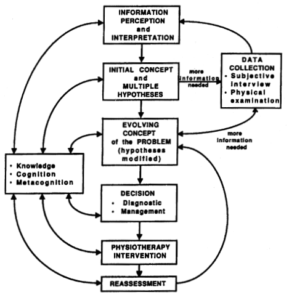
The Patient is the Reason!
What time to get out of bed?
Whats for Dinner?
What should I wear to the final year Uni ball?
When have I had enough to drink at the final year uni ball? Ok, Ill admit, not all of our reasoned choices are made so easily! Although the next day hangover might create a learned aversion!
It is our preconceived knowledge, ongoing data processing, past beliefs, attitudes and core values that guide us in the never -ending pursuit of living that perfect life!
We gather data from our patients, apply our knowledge base and process this information to form hypotheses around a diagnosis.
This forms the basis of our treatment plan.

https://www.physio-pedia.com/Clinical_Reasoning
The ability to apply sound clinical reasoning is generated from the quest to learn what you know you don’t know combining what you don’t know you don’t know!
Research comes and goes. Treatment fads and tech gimmicks are gone within the blink of an eye. When my career started, disc bulges were treated with mechanical traction and pelvic upslips HAD to be manipulated! Oh how times have changed!
Building the internal pattern recognition system comes with time and experience. It takes 100’s of shoulder assessments, to begin to sense the difference between rotator-cuff related pain and instability, just from the subjective history.
The quest toward becoming an expert clinician, requires an inquisitive mind and the ability to think critically. Understanding the principles that underpin the ‘why’ behind a certain technique or treatment approach is far more important than possessing a large artillery of manual skills.
This involves combinations of mini- manual treatments, assessing response to a movement or exercise stimulus, modification of the environment or sensitisation / repositioning of joints, body segments or tissues.
The scapular assistance test, manual patella glide and cueing hip hinge over anterior knee translation are all examples of clinical de-sensitising tests that might facilitate a direction for the rehabilitation pathway. These tests give clues as to which direction the patient is lacking when it comes to movement variability.
The famous novel by Daniel Kahneman – Thinking fast & Thinking Slow – provides a framework for our ability to clinically reason.
We must think on our feet in the patient appointment, moving through the process to form a swift diagnosis that convinces our patient that we know what we are talking about and gain ‘Buy in”.
After the appointment whirlwind, it’s critical that we reflect on our thought processes & biases, and undergo a critical appraisal of the overall outcome. It is in this process that we realise our shortcomings and provide a plan for the review appointment.
And finally………………………..
The absolute KEY INGREDIENT To effective clinical reasoning is the ability to LISTEN.
We must listen intently, observe body language and EMPATHISE with our patients to truly be able to provide the high level care that we aspire toward, and our patients so deserve!
Comments (0)